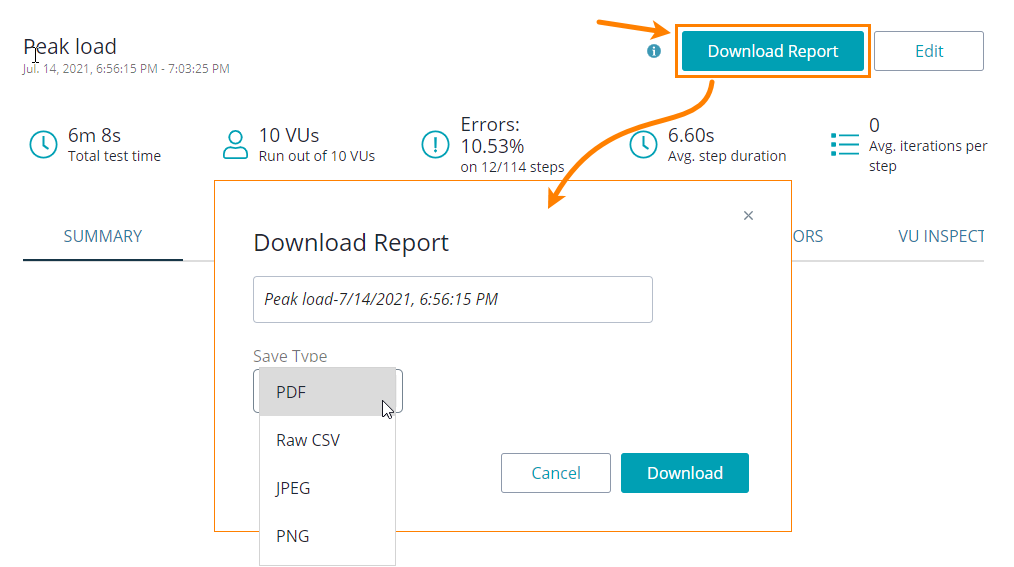To download test results as a file:
-
Open the results screen if it is hidden (see details).
-
Click Download Report. In the subsequent dialog, specify the file name, select the desired format, and click Download:
Supported formats
- CSV (Raw CSV in the dialog)
- JPEG
- PNG
The PDF, JPEG, and PNG files contain charts and data tables you can see in the tabs of the test results screen. The CSV file has results in a tabular format suitable for further processing.
Columns of the CSV file
If your load test is based on UI tests, then each row in the CSV file stores the results of a test step execution. For load tests based on API tests, each row stores the results of individual API requests. The columns store execution results of test steps (or requests):
| Column | Description | ||
|---|---|---|---|
|
URL_Step_Start |
The URL of the page the virtual user was on when the step execution was started. |
||
|
Date_Time |
The date and time the step execution was started. |
||
|
Status |
The execution status of the step. |
||
|
VU ID |
The unique ID of the virtual user that performed the step, including its IP address. |
||
|
Iteration Count |
The serial number of this iteration for the virtual user, specified in VU ID. |
||
|
Step Name |
The name of the performed step in the UI test, or |
||
|
Gross Duration (ms) |
Total step execution time (includes think times of individual test events). |
||
|
Redirect(ms) |
If the tested website has initially responded with an HTTP 301 or 302 redirect, this shows the time that a virtual user spent following the redirects until getting to the final URL. There may be several redirects, each needing another DNS lookup, TCP connection, and HTTP request, so the redirect time can be represented in greater details like this: 
|
||
|
DNS(ms) |
The time spent performing a DNS lookup, that is, obtaining the IP address of the website from a DNS server. If this value is elevated, it indicates that a virtual user had problems with reaching the DNS server and retrieving its response. |
||
|
Connect(ms) |
The time spent performing a TCP handshake, that is, establishing a connection to a web server after the DNS lookup. If this value is elevated, this indicates possible network and routing problems or low efficiency of the server bandwidth. |
||
|
Time to first byte (ms) |
The time spent waiting for the first byte of the response from the server. Its duration includes processing the requests, accessing the database of the server, selecting and generating the response, and depends on the server performance mostly. If this value is elevated, this indicates a possible high server load, problems with database queries, memory leaks, or other performance issues. |
||
|
Network Response time (ms) |
The execution time of the first request on the page (the first page in the test step). That is, the total time passed from the moment when the client sent the composed request until the moment when the page’s HTML code got downloaded. See also Aggregated Response Time below. |
||
|
DOM Load Time (ms) |
The total time it took to load and construct the DOM. The DOM is considered completed when the |
||
|
Event Time (ms) |
The time it took the page’s |
||
| Aggregated Response Time(ms) |
The total time the browser spent waiting for the response from the server. This value includes response times of all the requests in the test step. (The first request typically downloads the page’s HTML code. Subsequent requests download images, CSS and script files, and other resources. This value is a sum of all these response times). The response time of each request includes time periods spent on DNS resolving, setting up a connection to the tested server (if needed), processing redirects, and transferring data over the network. |
||
| 3rd-Party Response Time(ms) |
The response time taken for requests to domains different from the domain of the navigated URL. Examples of these third-party domains include Google Analytics, font storages, Facebook, weather info providers, and so on. This value helps you understand how much time your pages spent on requesting third-party sites. |
||
| Non-Blocking Think Time(ms) |
A sum of Think Time values that don’t pause the playback. A typical test step has multiple think times in it. Depending on the length and location of these Think Times, they might pause the test execution or not. For example, a Think Time at the beginning of the test step, most probably, doesn’t block the test run because at this time the browser is still sending requests and loading resources requested by the current page. However, a long Think Time at the end of the test step will most likely pause the test run, because all the resources, most probably, have been downloaded already, and the test engine spends time idling. |
||
| Think time(ms) |
The sum of all Think Times in the simulated teststep. This value doesn’t include non-blocking Think Times, that is, the Think Time values that didn’t cause pauses in the network activity (see above). |
||
| Front-end Processing Time(ms) |
The time spent on client-side processing. This includes time for running JavaScript client code, various actions with DOM, and so on.
|
||
|
Region |
The region, where the virtual user was situated.
|

